BMW X6 Review 2025: Price, specs & boot space
Written by Ivan Aistrop
Quick overview
Pros
- Superb interior
- The best car of its type to drive
- More spacious than you might think
Cons
- It's still a love-or-hate car
- Ride could be a touch smoother
- Gets pricey if you move up the range
Overall verdict on the BMW X6
"The latest BMW X6 makes a more convincing case for itself than ever. You might hate everything it stands for, but plenty of people love it, and the bold design is more cohesive than ever. Also, the interior is spot-on, the engines are good and the handling is impressive."
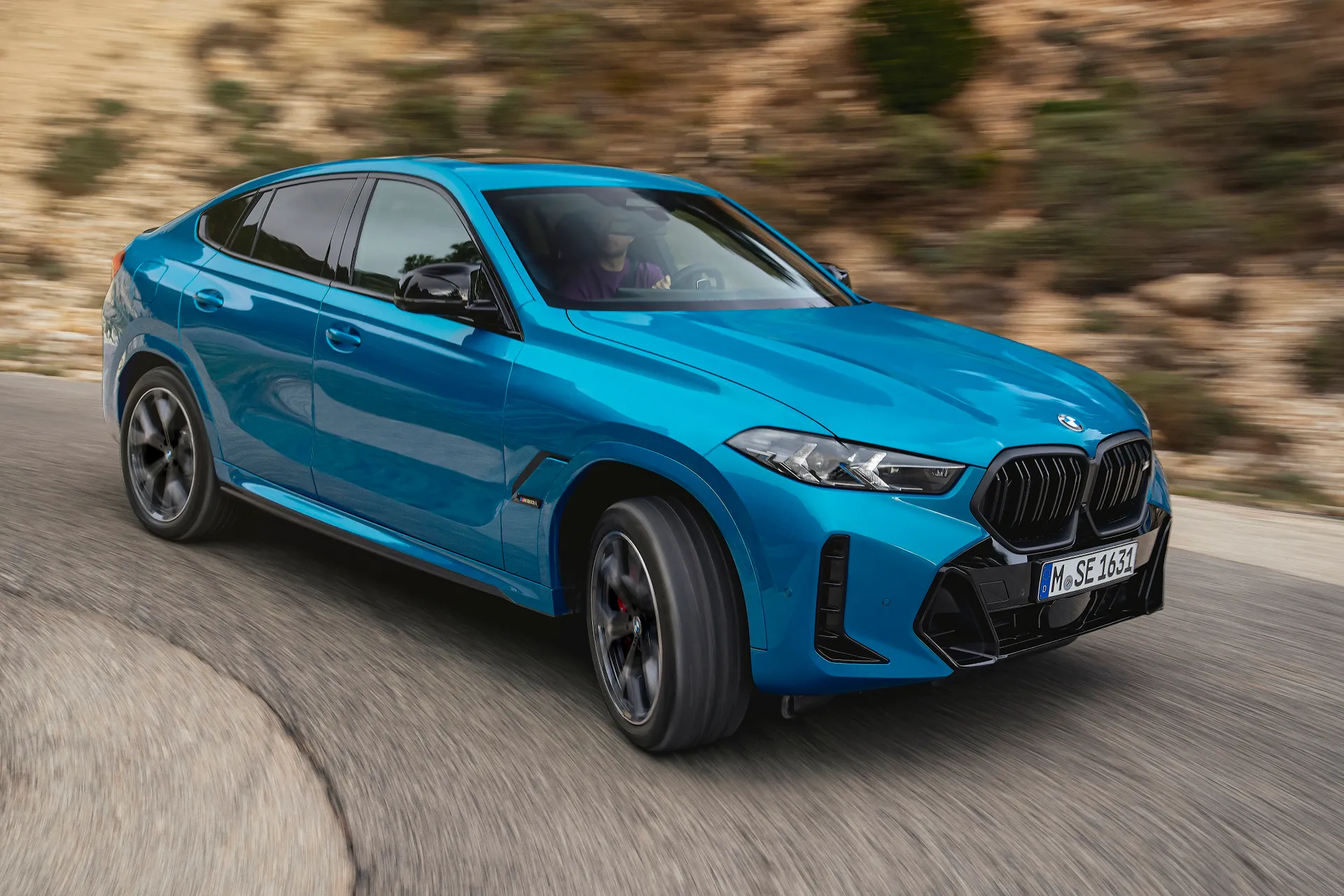
The BMW X6 has been a controversial car ever since it was first launched back in 2008. Traditionalists reacted strongly to its ‘coupe SUV’ design, which comprised a swooping coupe-like rear roofline on top of a regular premium SUV body. Now into its third generation, launched in 2019, the X6 is still a car enthusiasts love to hate. Find out whether they should in our BMW X6 review.
Customers think differently. BMW sold almost half a million X6s in the space of 12 years, and its growing number of rivals proves this sector has plenty of appeal. As the market for traditional coupes fades, so the idea of combining their sleek lines with the must-have SUV body style only seems to grow in appeal.
The X6 was pretty much the first of the breed, but it's been so popular that BMW has since launched the X4 and X2, both shrunken versions of the same theme. And the BMW X6's rivals keep on coming, the Range Rover Velar, the Porsche Cayenne Coupe, the Mercedes GLE Coupe, the Audi Q8, to name the closest.
Certainly, this is the most convincing BMW X6 yet. It looks less like a BMW X5 with a squashed rear end and more like a high-rise, high-impact coupe in its own right. The roofline has real drama, falling backwards before it even reaches the back of the front door, for a very distinctive and unique silhouette out on the road.
The front end is very ‘modern BMW’, with a massive grille and bold headlights. BMW will even sell you an illuminated grille, as if the sheer brashness of the weren't enough already.
Inside, the X6 is typical BMW, with big infotainment displays, vert few buttons and a fully electronic panel instead of traditional instruments ahead of the driver. We like the fact it feels more coupe-like to sit in, with a less ‘perched’ driving position. It still offers the desirably lofty view out, though, so X6 drivers can lord it over lesser mortals.
Despite the roofline, it’s surprisingly roomy for up to five people, even if the alternative X5 is bigger and more practical still. The coupe rear deck does mean boot space is smaller, but the sheer size of the car means it’s still surprisingly accommodating, so long as you don’t need to pack in anything too bulky.
BMW has offered a variety of petrol and diesel engines with the X6, all of them turbocharged. Traditionally, the best-seller has been the 3.0-litre six-cylinder xDrive30d, producing a healthy 286PS, or later, 298PS. The petrol alternative is also a six-cylinder, the 340PS (later 381PS) xDrive40i.
At the top of the line-up are the M Performance versions: the 400PS X6 M50d and 530PS X6 M50i, and if for some reason those just aren't fast and powerful enough, there's also the bonkers 625PS X6 M. Oddly, no plug-in hybrid version has been offered yet, despite it being available in the similar X5.
It goes without saying that the X6 is an expensive car, with new prices starting from around £77,000 in the UK. And it won’t take long on the configurator to notch that up to considerably more. However, it seems more realistic to spend big on this latest generation of X6 if it's your cup of tea, because it’s so much more cohesive and convincing than previously.
Looking for a used car for sale? We've got 100s of BMW Approved Used Cars for Sale for you to choose from, including a wide range of BMW X6s for sale.
Is the BMW X6 right for you?
One of the draws of the BMW X6 has always been its distinctive styling, and BMW has turned up the dial even further with this version. It’s more distinctive than ever, with its in-your-face front end, and the coupe roofline seems to work better than on any previous X6. We've no doubt a lot of people will still loathe it, but if you're in the camp that doesn't, then it'll certainly work for you.
It’s very luxurious inside, reflecting how BMW has upped its game with car interiors, and the array of electronic displays is certainly a talking point (even if they are less intuitive than BMW systems used to be).
We like how the X6 now feels more coupe-like, and love the impressive amount of space BMW has still been able to pack inside. For this alone, we can see why you’d choose it over a regular coupe. If outright space is more of a priority, though, the slightly cheaper BMW X5 might be a better bet.
What other cars are similar to the BMW X6?
Large SUV coupes have become quite a thing since BMW invented the sector back in 2008 with the original X6. Today, we have the Mercedes-Benz GLE Coupe, Audi Q8 and even a Porsche Cayenne Coupe. It’s a growing sector, much to the annoyance of some.
Land Rover might argue it was a pioneer here with the Range Rover Sport, but while it’s good looking, it doesn’t have the plunging coupe roofline that characterises these vehicles. The more svelte Range Rover Velar in high-end trims is probably a closer competitor. You could also argue that the Tesla Model X is a key rival, too, as despite being an electric car it has the performance and desirability to compete.
Comfort and design: BMW X6 interior
"The luxurious and welcoming interior of the BMW X6 is a very indulgent and high-end place to be. It’s a step up over previous versions, which always felt too closely related to lesser models."
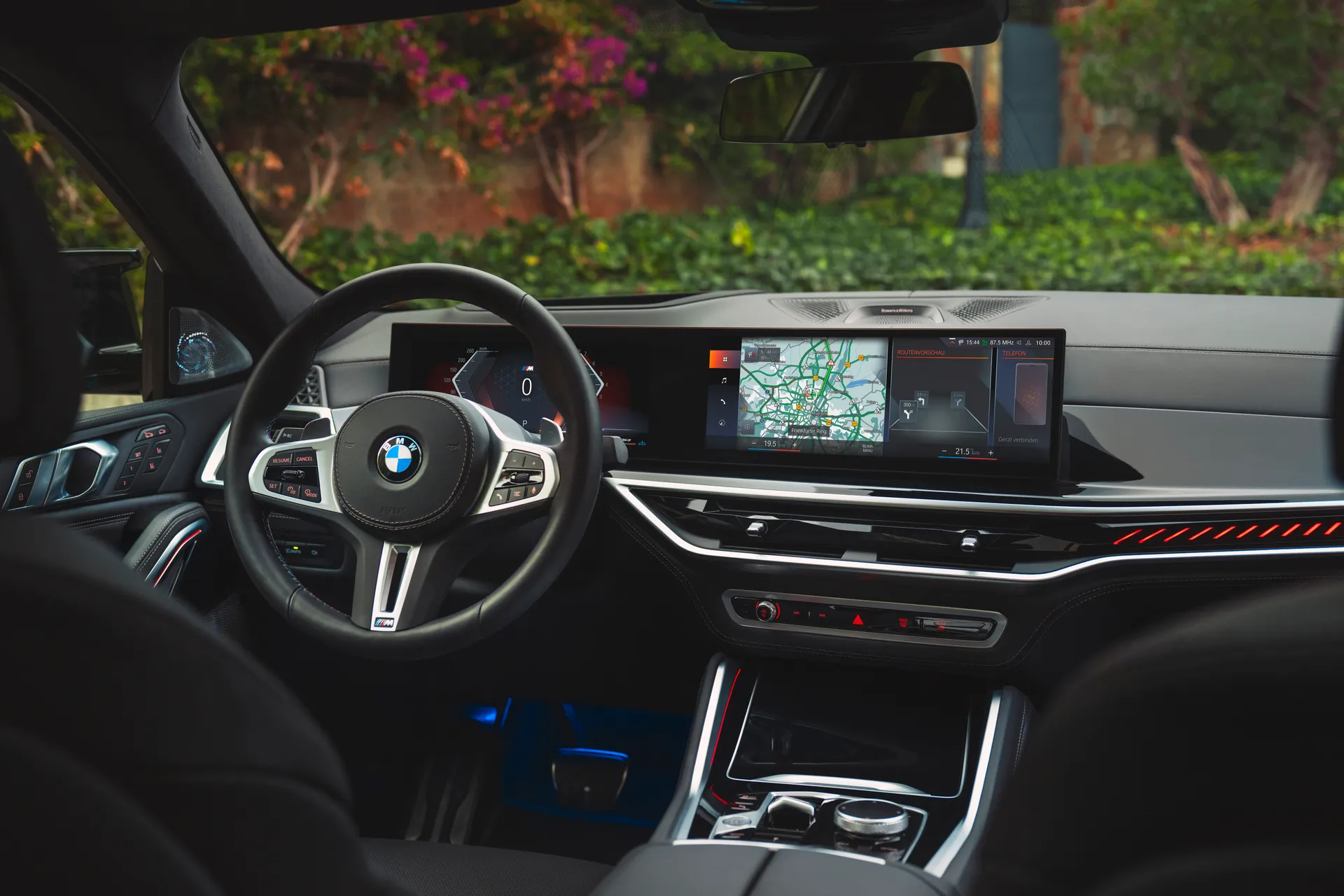
As was the case with the previous versions of the BMW X6, the latest model shares a lot of its cabin architecture with the X5. It's had a few changes to make it feel sportier and more coupe-like, though.
The driving position is improved a lot, with a less sat-up feel. It’s now more reclined, with the pedals positioned further ahead and the steering wheel in a more natural position. It’s more, well, coupe-like, rather than the van-like connotations you felt in the old one.
The design of the dashboard is angled towards the driver, in the traditional BMW way, but it’s also open-plan, with a flowing look rather than a stark and severe one. It has a feeling of width, gently bowing into the door panels in a smooth curve from one side to the other.
We love some of the details – the metal air vents, the knurled knobs to control airflow and the jewel-like feel to the rotary BMW iDrive controller in the centre console. At night, gently bathed in colour-selectable ambient backlighting, it looks very appealing indeed.
Even in the base X6 Sport, the seats are nicely bolstered and supportive. They feel like proper coupe seats, and hold you well through corners. M Sport models have alternative materials, and a sportier steering wheel, but no X6 feels particularly ‘un-sporting’.
Quality and finish
BMW has upped its game in terms of quality. It’s always been a brand that delivers a premium feel, but some of its earlier SUVs perhaps didn’t quite make the leap from premium into luxury. This one certainly does, with some wonderful materials including a soft-touch, fully-stitched dashboard cover, plush plastics further down and some beautifully finished major controls to grasp: the steering wheel, gearlever, even the door handles.
Press the electric window switches and there’s a muted click, rather than a cheap clack, and even the whirr of the window itself is damped and isolated, furthering the impression of quality. The high-resolution screen in the centre of the dash is also crisp and bright, as is the inset ‘black panel’ climate control system below.
The finishing touches are the soft leather, the sturdy and expensive-looking trim inlays, and the sheer tactility of the buttons that remain on the dashboard. It’s a BMW that is definitely now a match for its SUV coupe rival from Porsche.
Infotainment: Touchscreen, USB, nav and stereo in the BMW X6
The X6 has what's called BMW Operating System 7.0. This is billed as a fully connected system that links both the 12.3-inch touchscreen with the same-size digital instrument cluster: oh, and the BMW Connected app on your smartphone.
The system doesn’t have the menu structure of older BMW iDrive systems. Instead, it’s tile-based, and fully configurable, with shortcuts on the left-hand side. BMW packs so much into its latest infotainment, it was impossible to have the rotary menu of before. The system allows owners to configure what they want to see more of, and stick lesser-used functions in the background.
Sat-nav mapping is as brilliant as ever, and BMW’s connected services beam in live traffic information, weather details, parking information, fuel prices and other real-time data.
BMW lets you use it in multiple different ways: the touch-sensitive iDrive rotary controller, the touchscreen, via voice (its “Hey, BMW” virtual assistant is surprisingly effective), even gesture control. Or any combination you may see fit. It’s fully packed with technology and is now an extremely impressive modern infotainment system.
Space and practicality: BMW X6 boot space
Although it feels a little less SUV-like in terms of seating position, the BMW X6 still has the up-high stance that many find so appealing in an SUV. You look down at other vehicles, rather than go face-to-face with them, giving a reassuring and confidence-inspiring feeling of superiority behind the wheel.
It’s a big car with real presence; the BMW X6's exterior dimensions are 4935mm long, 2004mm wide and 1696mm tall. It's even longer than the X5, then, although it is slightly lower than the old X6, which helps make it look more dynamic.
The vast cabin has plenty of stowage space, with no end of massive cubbies that will swallow even the largest of smartphones, plus door bins and cup holders that are a match for any receptacle you can get from Starbucks.
It has less headroom than a BMW X5 in the rear, but it’s still spacious back there, with plenty of legroom and a really comfortable, supportive bench seat. Perhaps the smaller coupe-style windows and raked rear roofline mean it might feel a little claustrophobic for three people, due to the shortage of light, but for two it’s fine. It feels safe and confidence-inspiring back there.
It's worth noting, of course, that the X5 has a seven-seat option on most variants, whereas the X6 is a strict five-seater. That's true of all the X6's rivals, where the sloping roofline simply doesn't allow the headroom required to fit an actual human back there.
The boot is pretty huge as a result, however. It’s extremely long and very wide, which compensates for a lack of height due to the raked hatchback tailgate. Even with the seats up, the BMW X5's boot capacity is 580 litres; no less than 200 litres more than a Volkswagen Golf. Fold the seats and this grows to 1,530 litres. A BMW X5 is ultimately bigger and more practical, but the X6 is still a useful vehicle.
The fact it has lots of rear space and a large boot is also why some buyers may prefer the X6 over a regular coupe such as the BMW 8 Series. The X6 is more practical, more of the time, and requires far fewer compromises to live with day-to-day.
The outer two rear seats have Isofix mounts for child car seats, and there’s a passenger airbag cut-off switch. Just be careful you don’t knock your head on that plunging roofline as you get junior in the back.
Handling and ride quality: What is the BMW X6 like to drive?
"The BMW X6 has always stood out for being logic-defying to drive. It looks like an SUV from the front, feels like an SUV to sit in, but certainly doesn’t drive with anything like a lesser SUV’s truck-like, tip-toe attitude. We discovered that you can drift it on a racetrack even in the very first 2008 model and BMW has only made it more dynamic and engaging since then."
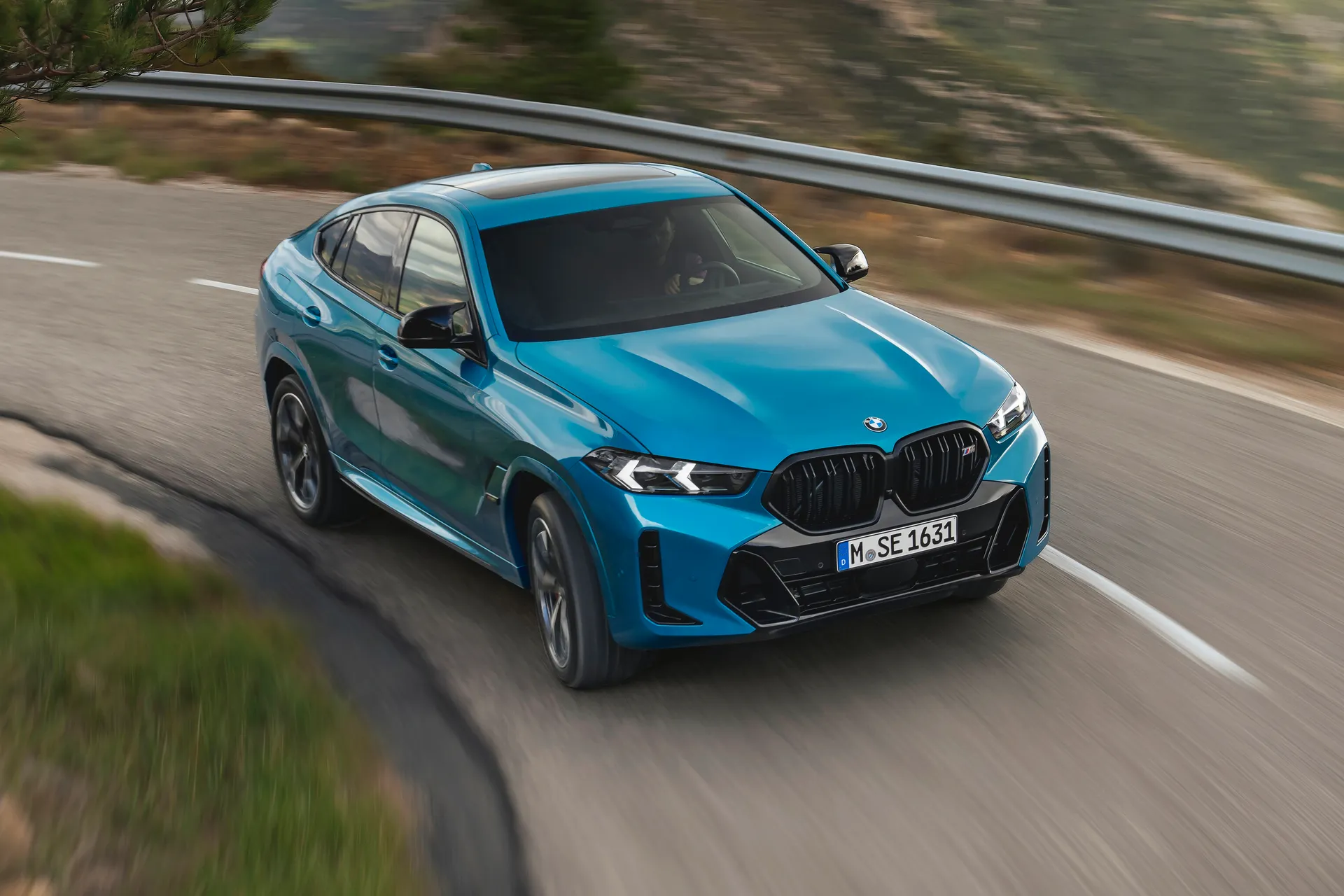
As standard, the X6 features adaptive dampers. This gives it a consistency of handling across all roads, at all speeds, in all conditions, and also allows the driver to choose just how sporty they want the car to feel. Even in regular mode, body roll is well contained, and the steering responds quickly, without any sort of mushy delay. Dial up the sport modes and it becomes even more tied down and alert, with the steering gaining extra weight and feedback. It feels more like a proper coupe than you’d ever imagine.
The standard xDrive all-wheel-drive system is brilliant, constantly adjusting power distribution so the X6 feels stable and planted. Stomp on the accelerator coming out of a corner and it just sits down and fires you away, a feeling that’s incredibly satisfying.
For even more agility at slower speeds and yet more stability at higher speeds, choose the integral rear-steer system. This turns the rear wheels in the opposite direction below a certain speed, reducing the car’s turning circle, then steers them in the same direction as you go faster. It’s very clever and effective.
Standard ride quality isn’t bad, although it's not as plush as you might expect from a big SUV. It’s firmer than an X5, of course, but it’s still not crashy or harsh: as you’d hope, given the size of the thing, and the sophisticated suspension’s considerable travel. If you want a more cushioned X6, you can optionally add on air suspension, which also allows drivers to raise and lower the ride height and brings even more isolation from bumps.
What engines and gearboxes are available in the BMW X6?
You really don’t need any more than the entry-level BMW X6 xDrive30d engine. It’s now fitted with 48-volt mild hybrid technology, which comprises an integrated starter-generator and a lithium-ion battery. Earlier versions of the engine had 286PS, while on later versions, it was upgraded to 298PS. The power is released in a satisfying surge when accelerating, and battery charge is clawed back again when you lift off to extend the engine-off range.
The engine feels snappier than ever thanks to electric fill-in boost from the mild hybrid system. Zero to 62mph takes 6.1 seconds and the surge it generates on the move makes it feel like a much bigger and more powerful engine. BMW has for a long time engineered alchemy into some of its engines and this entry-level diesel motor is one such example.
If that isn't potent enough, a more powerful 340PS (later upped to 352PS) variant of the same 3.0-litre straight-six diesel features in the X6 xDrive40d. Its efficiency is about the same, but this time it'll spear from 0-62mph in 5.5 seconds. It's a very potent unit but one that'll also cruise in a very relaxing way.
The X6 xDrive40i petrol is, at last, a worthwhile alternative to diesel. Previously, owners of petrol X6s have always been a bit short-changed, because the engines don’t quite serve up sufficient excitement or oomph given the extra fuel they consumed. This 3.0-litre straight-six turbo cures that, with an ample 340PS for 0-62mph in 5.5 seconds (later upgraded to 381PS and 5.4 seconds). It’s a revvier, livelier engine than the gutsy diesel, and is a fun drive in its own right.
We really like the X6 M50i’s (later renamed M60i) 4.4-litre V8, with a mighty 530PS, but it’s a niche model and you can't really use that much performance on tight, twisty European roads due to the sheer size of the thing. The X6 M? Well, that's the same engine with nigh on another 100PS and firmer suspension, so the previous point kinda counts double. The X6 M50d (no longer on sale) is marginally more popular than either, with its 3.0-litre six-cylinder quad-turbo motor putting out 400hp for 0-62mph in 5.2 seconds.
All BMW X6s use an excellent eight-speed automatic gearbox, with paddle shifters if you prefer to do the work yourself. It's much more responsive than Audi's rather laggy eight-speed unit, for example.
Refinement and noise levels
Refinement also reflects the BMW X6’s status as a luxury model. It is very smooth-running, with even the diesel engines producing little more than a murmur. For such a big machine, it flows through the air quietly, showing the benefits of plenty of time in the wind tunnel and lots of acoustic noise-isolating features.
Some of the bigger alloy wheel options can generate a bit of tyre roar as speeds rise, but so long as you keep it fairly sensible here, it’s not too excessive. And while both M Performance models have 22-inch alloys, they also have enthusiastic engine notes of their own that you won’t mind hearing a bit more of, particularly with the magnificent V8. Indeed, the M Sport exhaust system lets you choose what sort of noise you want, literally at the press of a button.
Safety equipment: How safe is the BMW X6?
As it is related to the BMW X5, safety organisation Euro NCAP encourages us to look at the 2018 crash-test of that vehicle to get an idea how the X6 performs. The X5 was rated a five-star car, with 89 percent for adult occupant protection, 86 percent for child occupant protection, 75 percent for protecting vulnerable road users, and 75 percent for safety assist features.
Front airbags, including a driver’s knee airbag, are backed up with side airbags for front and rear passengers, and standard chest and pelvis airbags for those in the front: the latter are optional for rear-seat passengers. BMW also fits a seatbelt reminder for all five seats, although that's par for the course these days.
There’s an extensive set of active safety assist features: an active bonnet that pops up to protect pedestrians, autonomous emergency braking that detects pedestrians, cyclists and cars; a speed limiter and a lane-keep assist system, all as standard. You'd expect that at this price point.
MPG and fuel costs: What does the BMW X6 cost to run?
"Tested to the WLTP fuel economy standard, the BMW X6 actually looks pretty decent in terms of efficiency."
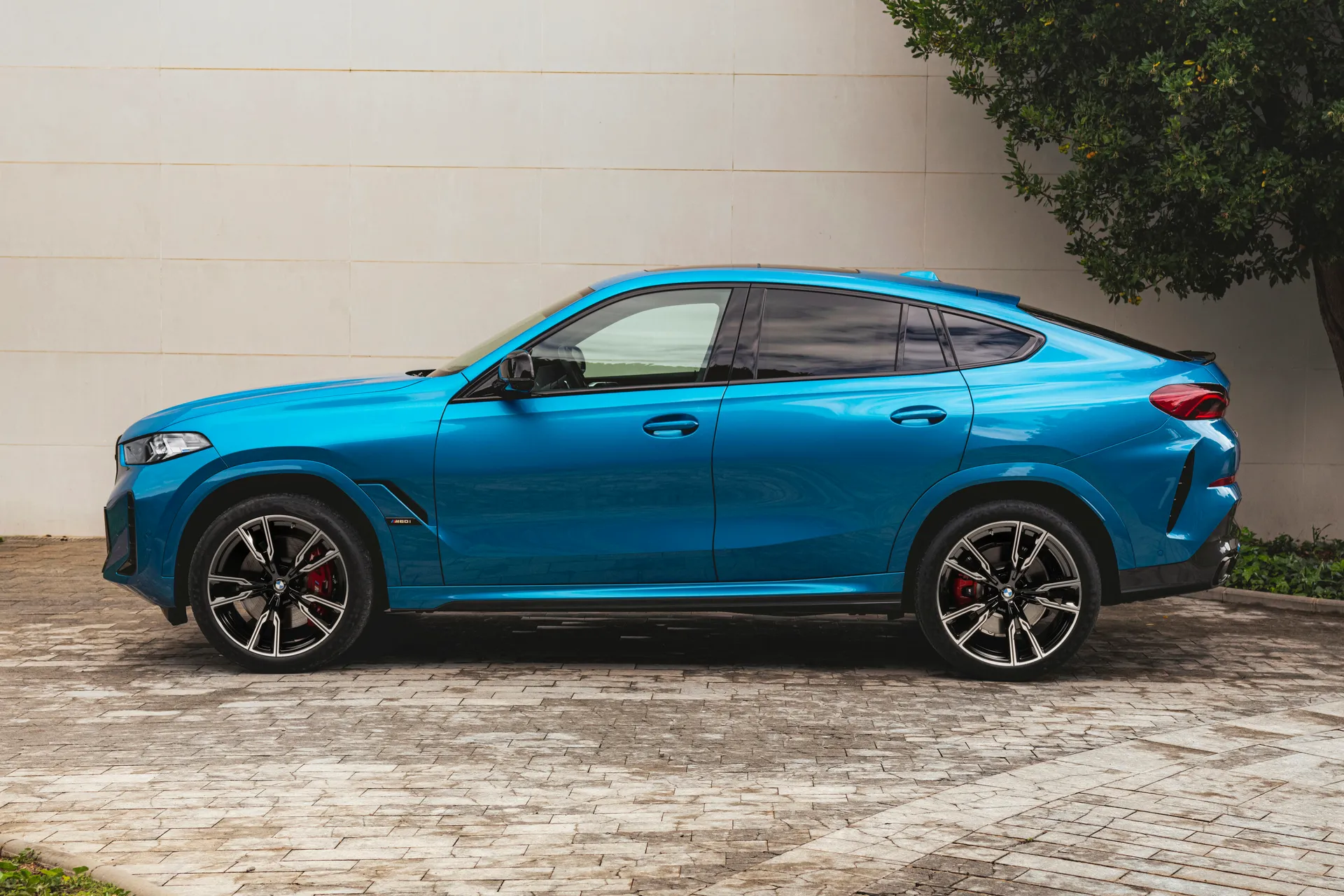
Using the WLTP test regime, the BMW X6 xDrive30d averages up to 42mpg combined: you might even see over 45mpg on a run with a gentle right foot.
The more powerful X6 xDrive 40d will still achieve just over 40mpg, while even the X6 xDrive40i petrol isn’t so bad at 29-31mpg depending on spec, given its fruity power output.
The thirstiest of the normal range is the M50i, which will average no more than 23.5mpg. The X6 M? 21.4mpg. Both of those figures will drop like a stone if you use the performance, however.
How reliable is the BMW X6?
Prestige brands haven't exactly covered themselves in glory in the latest HonestJohn.co.uk Satisfaction Index. Our sister website publishes an annual list pulling out the 10 car manufacturers that were rated by owners as the least reliable, and the latest list features BMW's bitter rivals Mercedes-Benz (6th worst), Audi (9th worst) and Jaguar (10th worst). Where the X6 is concerned, Porsche and Land Rover are also close rivals, and both also feature, Porsche being 8th worst and Land Rover being the worst of the lot.
Happily, for X6 buyers, there was no place for BMW on that list. However, it can't match the might of Lexus in the area of mechanical dependability, which was voted as the most reliable manufacturer overall.
It's not particularly surprising, then, to see Lexus top the manufacturer rankings outright when it comes to overall customer satisfaction. It's more of a surprise to see BMW (12th place out of 29 manufacturers) leapfrogged in the overall standings by Porsche (4th), Jaguar (5th) and Land Rover (9th), although the German marque did manage to stay ahead of domestic rivals Audi (16th) and Mercedes-Benz (20th).
We haven't heard any reliability horror stories regarding the X6 specifically. Like all BMWs, the X6 comes with a three-year, unlimited-mileage warranty.
Insurance groups and costs
Insurance costs for the latest BMW X6 are likely to be extremely high. Almost the entire range falls into the top group 50 insurance rating. Only the entry-level xDrive30d Sport fails to hit the big 5-0 (it’s rated in insurance group 49).
The X6 is a desirable machine with a heady price tag and, even in base guise, very swift performance, so don’t expect it to be a particular bargain on the insurance front.
VED car tax: What is the annual road tax on a BMW X6?
All BMW X6s are expensive, and so are liable for the ‘expensive car’ VED (road tax) premium. This sees owners pay a surcharge on top of the annual standard-rate charge for a five-year period between years two and six of the car's life. You can't get around it by buying used, either, because this liability is passed on to subsequent owners until the car's seventh birthday. The standard flat rate currently stands at £190 per year, while the additional surcharge is £490 per year, so you're looking at a chunk of change each year. Then again, if you can afford to buy, insure and fuel an X6, then an annual outlay of 600 notes probably isn't going to deter you.
How much should you be paying for a used BMW X6?
"If you're buying brand new, prices for the BMW X5 start at around £77,000. Go for the top-of-the-range X6 M Competition, meanwhile, and you'll be spending upwards of £130,000."
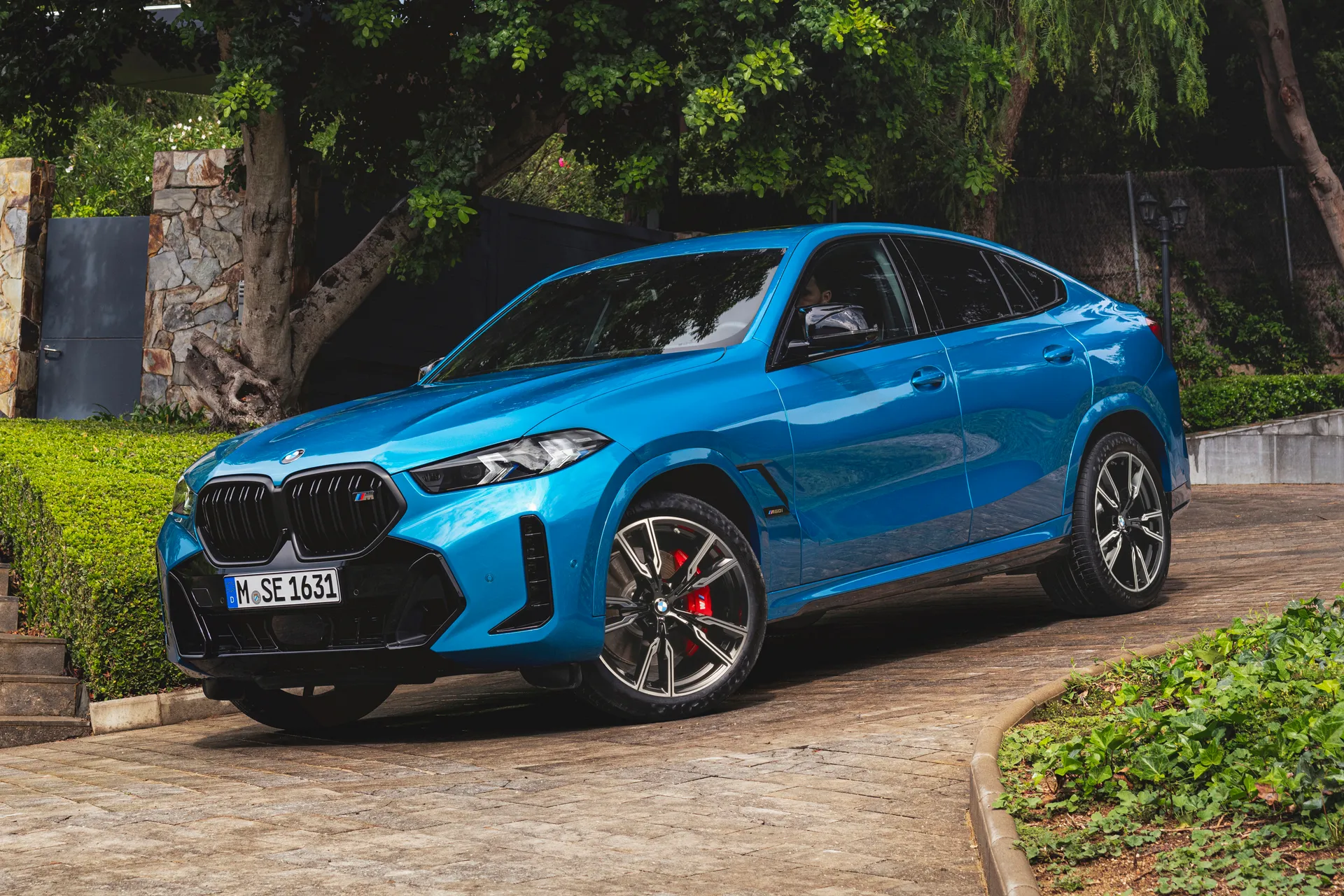
Cars like these usually depreciate heavily, though, and so is the case with the X6, so you can make some huge savings by buying used. A quick browse of the heycar listings shows that 30d M Sport models (these are by far the most commonplace on the used car market) from 2020 or 2021 can be had for around £40,000 when carrying between 25,000 and 45,000 miles on the clock. If you don't mind a mileage of around 80,000 miles, you can knock a further five grand off that.
Trim levels and standard equipment
All latest-generation BMW X6s have a very extensive list of standard equipment, although there's plenty of options to add on if you want even more lavish tech or finishes.
In the entry-level BMW X6 Sport (no longer offered brand new) the smallest wheels are 19 inches in diameter (but can be optioned up), the headlights are adaptive LEDs with high beam assist, the stereo is enhanced with a BMW Advanced loudspeaker system, the front sports seats are heated, and the BMW Parking Assistant kit is also included. Even the infotainment is the high-grade Connected Package Professional.
The BMW X6 M Sport adds a more distinctive front and rear bumper design, high-gloss black side window surrounds, body colour wheelarches, an M Sport exhaust and blue M Sport brake calipers. M Performance versions have even larger 22-inch alloys, Adaptive M Suspension Professional and an M Sport differential that makes them even pointier and more responsive in corners.
Ask the heycar experts: common questions
Is the BMW X6 worth buying?
How much does a BMW X6 cost?
Where is the BMW X6 built?
Get our latest advice, news and offers
Keep me updated by email with the latest advice, news and offers from heycar.
By submitting you agree to our privacy policy



